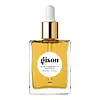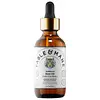What's inside
What's inside
 Key Ingredients
Key Ingredients

 Benefits
Benefits

 Concerns
Concerns

 Ingredients Side-by-side
Ingredients Side-by-side

Dimethicone
EmollientDimethiconol
EmollientTrisiloxane
Skin ConditioningMel
EmollientPrunus Amygdalus Dulcis Oil
Skin ConditioningCocos Nucifera Oil
MaskingArgania Spinosa Kernel Oil
EmollientPassiflora Incarnata Seed Oil
Skin ProtectingTocopheryl Acetate
AntioxidantParfum
MaskingGardenia Taitensis Flower Extract
Skin ConditioningCI 47000
Cosmetic ColorantTocopherol
AntioxidantCI 26100
Cosmetic ColorantCoumarin
PerfumingHexyl Cinnamal
PerfumingLimonene
PerfumingLinalool
PerfumingCaprylic/Capric Triglyceride
MaskingCarthamus Tinctorius Seed Oil
MaskingParfum
MaskingSesamum Indicum Seed Oil
EmollientWithania Somnifera Root Extract
Skin ConditioningPhyllanthus Emblica Fruit Extract
HumectantBacopa Monnieri Leaf Extract
Skin ConditioningEclipta Prostrata Extract
Skin ConditioningSimmondsia Chinensis Seed Oil
EmollientRicinus Communis Seed Oil
MaskingPueraria Lobata Root Extract
HumectantTribulus Terrestris Root Extract
Skin ConditioningStereospermum Suaveolens Root Extract
Skin ConditioningSolanum Xanthocarpum Root Extract
MaskingSolanum Indicum Root Extract
Skin ConditioningPremna Serratifolia Root Extract
Skin ConditioningGlycyrrhiza Glabra Root Extract
BleachingBeta-Sitosterol
Emulsion StabilisingGmelina Arborea Root Extract
Skin ConditioningDesmodium Gangeticum Root Extract
Skin ConditioningAegle Marmelos Root Extract
Skin ConditioningSqualene
EmollientOlea Europaea Fruit Oil
MaskingVitis Vinifera Seed Oil
EmollientTocopherol
AntioxidantPhenoxyethanol
PreservativeBenzyl Salicylate
PerfumingIsoeugenol
PerfumingLinalool
PerfumingCaprylic/Capric Triglyceride, Carthamus Tinctorius Seed Oil, Parfum, Sesamum Indicum Seed Oil, Withania Somnifera Root Extract, Phyllanthus Emblica Fruit Extract, Bacopa Monnieri Leaf Extract, Eclipta Prostrata Extract, Simmondsia Chinensis Seed Oil, Ricinus Communis Seed Oil, Pueraria Lobata Root Extract, Tribulus Terrestris Root Extract, Stereospermum Suaveolens Root Extract, Solanum Xanthocarpum Root Extract, Solanum Indicum Root Extract, Premna Serratifolia Root Extract, Glycyrrhiza Glabra Root Extract, Beta-Sitosterol, Gmelina Arborea Root Extract, Desmodium Gangeticum Root Extract, Aegle Marmelos Root Extract, Squalene, Olea Europaea Fruit Oil, Vitis Vinifera Seed Oil, Tocopherol, Phenoxyethanol, Benzyl Salicylate, Isoeugenol, Linalool
 Reviews
Reviews

Alternatives
Ingredients Explained
These ingredients are found in both products.
Ingredients higher up in an ingredient list are typically present in a larger amount.
Linalool is a fragrance and helps add scent to products. It's derived from common plants such as cinnamon, mint, citrus, and lavender.
Like Limonene, this ingredient oxidizes when exposed to air. Oxidized linalool can cause allergies and skin sensitivity.
This ingredient has a scent that is floral, spicy tropical, and citrus-like.
Learn more about LinaloolParfum is a catch-all term for an ingredient or more that is used to give a scent to products.
Also called "fragrance", this ingredient can be a blend of hundreds of chemicals or plant oils. This means every product with "fragrance" or "parfum" in the ingredients list is a different mixture.
For instance, Habanolide is a proprietary trade name for a specific aroma chemical. When used as a fragrance ingredient in cosmetics, most aroma chemicals fall under the broad labeling category of “FRAGRANCE” or “PARFUM” according to EU and US regulations.
The term 'parfum' or 'fragrance' is not regulated in many countries. In many cases, it is up to the brand to define this term.
For instance, many brands choose to label themselves as "fragrance-free" because they are not using synthetic fragrances. However, their products may still contain ingredients such as essential oils that are considered a fragrance by INCI standards.
One example is Calendula flower extract. Calendula is an essential oil that still imparts a scent or 'fragrance'.
Depending on the blend, the ingredients in the mixture can cause allergies and sensitivities on the skin. Some ingredients that are known EU allergens include linalool and citronellol.
Parfum can also be used to mask or cover an unpleasant scent.
The bottom line is: not all fragrances/parfum/ingredients are created equally. If you are worried about fragrances, we recommend taking a closer look at an ingredient. And of course, we always recommend speaking with a professional.
Learn more about ParfumTocopherol (also known as Vitamin E) is a common antioxidant used to help protect the skin from free-radicals and strengthen the skin barrier. It's also fat soluble - this means our skin is great at absorbing it.
Vitamin E also helps keep your natural skin lipids healthy. Your lipid skin barrier naturally consists of lipids, ceramides, and fatty acids. Vitamin E offers extra protection for your skin’s lipid barrier, keeping your skin healthy and nourished.
Another benefit is a bit of UV protection. Vitamin E helps reduce the damage caused by UVB rays. (It should not replace your sunscreen). Combining it with Vitamin C can decrease sunburned cells and hyperpigmentation after UV exposure.
You might have noticed Vitamin E + C often paired together. This is because it is great at stabilizing Vitamin C. Using the two together helps increase the effectiveness of both ingredients.
There are often claims that Vitamin E can reduce/prevent scarring, but these claims haven't been confirmed by scientific research.
Learn more about Tocopherol